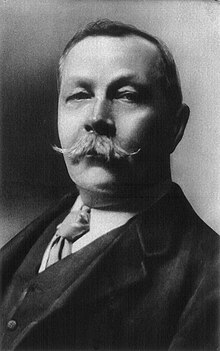About the Book: "The Adventure of the Blue Carbuncle", one of the 56 short Sherlock Holmes stories written by British author Sir Arthur Conan Doyle, is the seventh story of twelve in The Adventures of Sherlock Holmes. The story was first published in Strand Magazine in January 1892.
About the Author: Arthur Ignatius Conan Doyle was born on 22 May 1859 at 11 Picardy Place, Edinburgh, Scotland. From 1876 to 1881, he studied medicine at the University of Edinburgh, including a period working in the town of Aston (now a district of Birmingham) and in Sheffield, as well as in Shropshire at Ruyton-XI-Towns. While studying, Doyle began writing short stories. His earliest extant fiction, "The Haunted Grange of Goresthorpe", was unsuccessfully submitted to Blackwood's Magazine. His first published piece "The Mystery of Sasassa Valley", a story set in South Africa, was printed in Chambers's Edinburgh Journal on 6 September 1879. On 20 September 1879, he published his first non-fiction article, "Gelsemium as a Poison" in the British Medical Journal. In 1882 he joined former classmate George Turnavine Budd as his partner at a medical practice in Plymouth, but their relationship proved difficult, and Doyle soon left to set up an independent practice. Arriving in Portsmouth in June of that year with less than £10 (£900 today) to his name, he set up a medical practice at 1 Bush Villas in Elm Grove, Southsea. The practice was initially not very successful. While waiting for patients, Doyle again began writing stories and composed his first novels, The Mystery of Cloomber, not published until 1888, and the unfinished Narrative of John Smith, which would go unpublished until 2011. He amassed a portfolio of short stories including "The Captain of the Pole-Star" and "J. Habakuk Jephson's Statement", both inspired by Doyle's time at sea, the latter of which popularized the mystery of the Mary Celeste and added fictional details such as the perfect condition of the ship (which had actually taken on water by the time it was discovered) and its boats remaining on board (the one boat was in fact missing) that have come to dominate popular accounts of the incident. Doyle struggled to find a publisher for his work. His first significant piece, A Study in Scarlet, was taken by Ward Lock Co. on 20 November 1886, giving Doyle £25 for all rights to the story. The piece appeared later that year in the Beeton's Christmas Annual and received good reviews in The Scotsman and the Glasgow Herald. The story featured the first appearance of Watson and Sherlock Holmes, partially modeled after his former university teacher Joseph Bell. Doyle wrote to him, "It is most certainly to you that I owe Sherlock Holmes ... Round the center of deduction and inference and observation which I have heard you inculcate I have tried to build up a man." Robert Louis Stevenson was able, even in faraway Samoa, to recognize the strong similarity between Joseph Bell and Sherlock Holmes: "My compliments on your very ingenious and very interesting adventures of Sherlock Holmes. ... Can this be my old friend Joe Bell?" Other authors sometimes suggest additional influences—for instance, the famous Edgar Allan Poe character C. Auguste Dupin. A sequel to A Study in Scarlet was commissioned and The Sign of the Four appeared in Lippincott's Magazine in February 1890, under agreement with the Ward Lock company. Doyle felt grievously exploited by Ward Lock as an author new to the publishing world and he left them. Short stories featuring Sherlock Holmes were published in the Strand Magazine. Doyle first began to write for the 'Strand' from his home at 2 Upper Wimpole Street, now marked by a memorial plaque. In this period, however, Holmes was not his sole subject and in 1893, he collaborated with J.M. Barrie on the libretto of Jane Annie. Doyle was found clutching his chest in the hall of Windlesham Manor, his house in Crowborough, East Sussex, on 7 July 1930. He died of a heart attack at the age of 71. His last words were directed toward his wife: "You are wonderful." At the time of his death, there was some controversy concerning his burial place, as he was avowedly not a Christian, considering himself a Spiritualist. He was first buried on 11 July 1930 in Windlesham rose garden. He was later reinterred together with his wife in Minstead churchyard in the New Forest, Hampshire. Carved wooden tablets to his memory and to the memory of his wife are held privately and are inaccessible to the public. That inscription reads, "Blade straight / Steel true / Arthur Conan Doyle / Born May 22nd 1859 / Passed On 7th July 1930." The epitaph on his gravestone in the churchyard reads, in part: "Steel true/Blade straight/Arthur Conan Doyle/Knight/Patriot, Physician, and man of letters". Undershaw, the home near Hindhead, Haslemere, south of London, that Doyle had built and lived in between October 1897 and September 1907, was a hotel and restaurant from 1924 until 2004. It was then bought by a developer and stood empty while conservationists and Doyle fans fought to preserve it. In 2012 the High Court ruled that the redevelopment permission be quashed because proper procedure had not been followed. A statue honours Doyle at Crowborough Cross in Crowborough, where he lived for 23 years. There is also a statue of Sherlock Holmes in Picardy Place, Edinburgh, close to the house where Doyle was born.
My Review: A very entertaining mystery short story from the Sherlock Holmes short stories collection. The plot is quite simple and intelligent: Watson visits his friend Holmes at Christmas time and finds him contemplating a battered old hat, brought to him by the commissionaire Peterson after the hat and a Christmas goose had been dropped by a man in a scuffle with some street ruffians. Peterson takes the goose home to eat, but later returns to Holmes with a blue carbuncle his wife had found in the bird's crop (throat). Holmes makes some interesting deductions concerning the owner of the hat from simple observations of its condition, conclusions amply confirmed when an advertisement for the owner produces the man himself: Henry Baker.
Holmes cannot resist such an intriguing mystery, and he and Watson set out across the city to determine exactly how the jewel, stolen from the Countess of Morcar during her stay at a hotel, wound up in a goose's crop. The man who dropped the goose, Mr. Henry Baker, comes to reclaim his hat in response to Holmes' advertisement. Holmes drops hints about how he saved the "innards" of the goose, but Baker fails to respond to them, simply saying that he is afraid goose remains are not much use. He does, however, give Holmes valuable information, eventually leading him to the conclusive stage of his investigation, at Covent Garden. Holmes offers a fresh goose to Henry Baker, who responds with gladness and departs, whereupon Holmes tells Watson that Baker is eliminated from the suspect list as he obviously knows nothing about the carbuncle. At Covent Garden, a salesman named Breckinridge gets angry with Holmes, complaining about all the people who have pestered him about geese sold recently to the landlord of the Alpha Inn. Clearly, someone else knows that the carbuncle was in a goose and is looking for the bird.
Holmes expects that he will have to visit the goose supplier in Brixton, but it proves unnecessary: the other "pesterer" that the salesman mentioned shows up right then, a cringing little man named James Ryder whom Holmes prevails upon to tell the whole sordid story, by first mentioning that Ryder is probably looking for a goose with a black bar on its tail, a remarkable bird that "[laid] an egg after it was dead". Of course, Holmes has already deduced most of it.
Ryder, believing he was being pursued for the theft, fed the carbuncle to a goose being bred by his sister Maggie Oakshott. He was to have had that goose as a gift, but lost track of which one it was.
When Ryder cut open the goose and found no gem, he went back to his sister, who had provided the Alpha Inn geese, and asked if there was more than one goose with a black bar on its tail. She said there were two, but he was too late: she had sold it to Breckinridge at Covent Garden. Breckinridge had already sold the geese to the Alpha Inn, and the other goose with a black bar on its tail had found its way to Henry Baker as his Christmas fowl. Ryder and his accomplice — the countess's maid, Catherine Cusack — contrived to frame John Horner, a plumber who worked at the same hotel as Ryder and had previously been imprisoned for robbery, for the crime.
Holmes, however, does not take the standard action against the man, it being Christmas, concluding that arresting the clearly anguished Ryder will only make him into a more hardened criminal later. Ryder flees to the continent and Horner will be freed as the case against him will collapse without Ryder's perjured testimony. Holmes remarks that he is not retained by the police to remedy their deficiencies.
I recommend this book to all readers that love a good mystery story, mainly those who enjoy Sherlock Holmes mystery stories.
If you read my review, feel free to leave a comment.



No comments:
Post a Comment